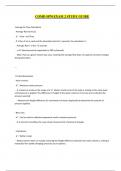Exam (elaborations)
COMD 5070 EXAM 2 STUDY GUIDE
- Course
- Institution
COMD 5070 EXAM 2 STUDY GUIDE Average Air Flow Calculation - Average flow formula: ️ Flow = Air/Time - If 1 liter of air is used and the phonation lasts for 5 seconds, the calculation is: - Average flow = 1 liter / 5 seconds - = 0.2 liters/second (or equivalent to 200 cc/second) - Note...
[Show more]



